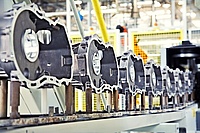
AAF Proves Validity of Energy Savings Through In-Situ Data Logging
- Leading University Medical Center located in Texas, serving the Southwestern United States
- 996-bed facility
- 49 owned, operated, joint-ventured, and affiliated hospitals
One of the largest not-for-profit healthcare systems in Texas recently decided to reduce energy costs by engaging a leading real estate and environmental management firm. AAF International advised that conducting a comparison study of the current filters through a direct method of measuring their HVAC system performance would identify improvement opportunities and provide evidence that alternative filter types would save energy and money.
The goals were to reduce energy costs and Total Cost of Ownership (TCO), reduce facility risk with final filters that did not suffer in performance, and select filters that would last at least 6 months or longer. The four-week comparison study used a direct method of energy logging, evaluating the hospital’s current filters against recommended filters to document the reduced overall cost. This direct method of measuring the $iwgyr—dollars per resistance iwg (inch of water gauge) per year—is extremely precise, yielding hard data in order to systematically evaluate the value of a proposed filtration solution.

The direct energy logging data indicated that the current system added significant energy cost to the hospital’s bottom line. The recommended AAF filters had significantly less resistance and greater airflow, minimizing operating costs.
The hard data demonstrated that the $iwgyr for AHU 1 was $8,000, and the $iwgyr for AHU 2 was $4,902. It projected that the energy savings for AHU 1, if the recommended filters were adopted, was $11,800 per year, while the projected energy savings for AHU 2 was $7,100 per year. This recommended system, based on the precise results of hard data, was found to be a much more efficient and effective solution for the hospital’s needs. A regular changeout schedule was also recommended to meet their objectives.
When the testing data was extrapolated to encompass all of the buildings on the hospital campus, the annual energy savings totaled an incredible $398,725. Based on this analysis, the projected annual energy savings for all 10 of their facilities added up to over $571,640.
AAF International then revisited the site to perform the same testing using TCO Diagnostic, an advanced analytical software tool. The analysis projected the exact same calculations as the direct energy logging method. This validated that the energy savings and total cost of ownership calculations of TCO Diagnostic were accurate and proved the program’s reliability for energy savings through filtration. It is this ability to combine real-life, local filter performance results with local operating costs that differentiates TCO Diagnostic from all other total cost of ownership programs.
- Leading University Medical Center located in Texas, serving the Southwestern United States
- 996-bed facility
- 49 owned, operated, joint-ventured, and affiliated hospitals
One of the largest not-for-profit healthcare systems in Texas recently decided to reduce energy costs by engaging a leading real estate and environmental management firm. AAF International advised that conducting a comparison study of the current filters through a direct method of measuring their HVAC system performance would identify improvement opportunities and provide evidence that alternative filter types would save energy and money.
The goals were to reduce energy costs and Total Cost of Ownership (TCO), reduce facility risk with final filters that did not suffer in performance, and select filters that would last at least 6 months or longer. The four-week comparison study used a direct method of energy logging, evaluating the hospital’s current filters against recommended filters to document the reduced overall cost. This direct method of measuring the $iwgyr—dollars per resistance iwg (inch of water gauge) per year—is extremely precise, yielding hard data in order to systematically evaluate the value of a proposed filtration solution.

The direct energy logging data indicated that the current system added significant energy cost to the hospital’s bottom line. The recommended AAF filters had significantly less resistance and greater airflow, minimizing operating costs.
The hard data demonstrated that the $iwgyr for AHU 1 was $8,000, and the $iwgyr for AHU 2 was $4,902. It projected that the energy savings for AHU 1, if the recommended filters were adopted, was $11,800 per year, while the projected energy savings for AHU 2 was $7,100 per year. This recommended system, based on the precise results of hard data, was found to be a much more efficient and effective solution for the hospital’s needs. A regular changeout schedule was also recommended to meet their objectives.
When the testing data was extrapolated to encompass all of the buildings on the hospital campus, the annual energy savings totaled an incredible $398,725. Based on this analysis, the projected annual energy savings for all 10 of their facilities added up to over $571,640.
AAF International then revisited the site to perform the same testing using TCO Diagnostic, an advanced analytical software tool. The analysis projected the exact same calculations as the direct energy logging method. This validated that the energy savings and total cost of ownership calculations of TCO Diagnostic were accurate and proved the program’s reliability for energy savings through filtration. It is this ability to combine real-life, local filter performance results with local operating costs that differentiates TCO Diagnostic from all other total cost of ownership programs.

 FHK Polska
FHK Polska PureMedion Kft.
PureMedion Kft. Elfa spol. s r. o.
Elfa spol. s r. o. Ecotip d.o.o.
Ecotip d.o.o.

